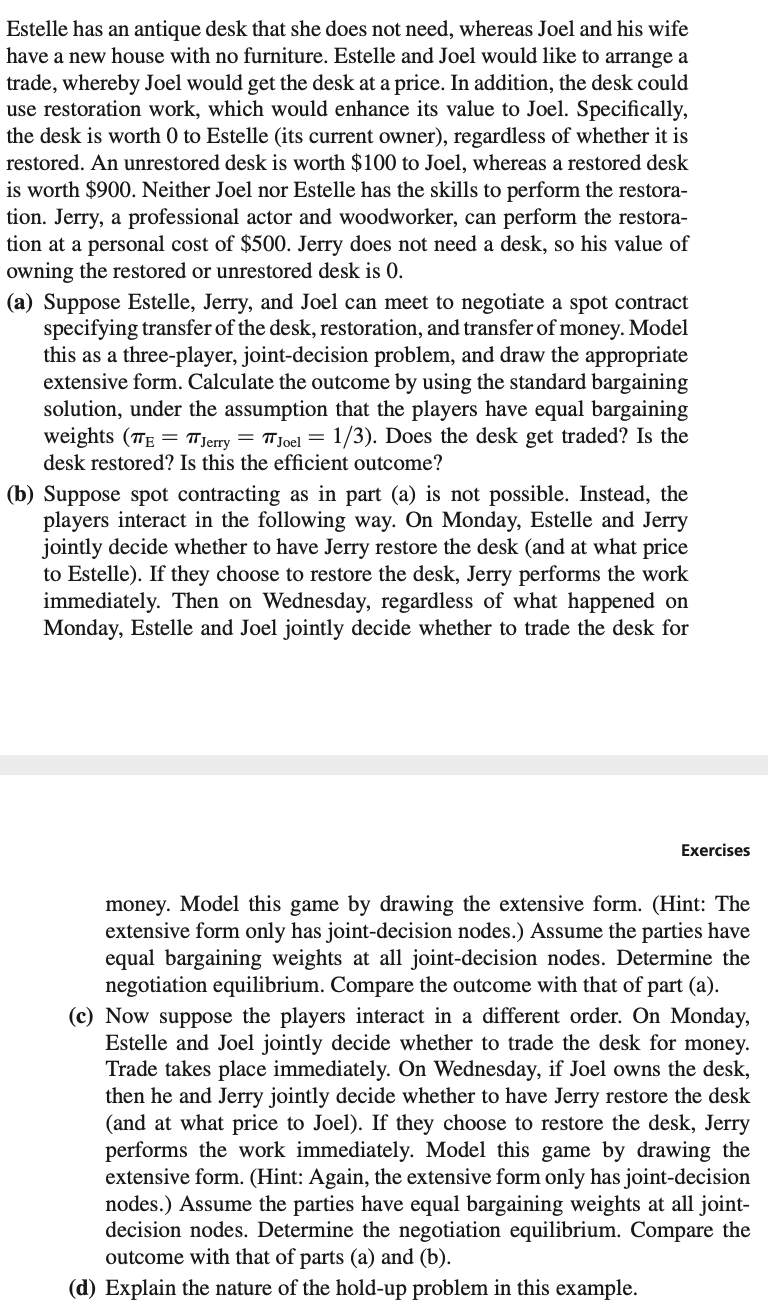Can you help me with this question please
Estelle has an antique desk that she does not need, whereas Joel and his wife have a new house with no furniture. Estelle and Joel would like to arrange a trade, whereby Joel would get the desk at a price. In addition, the desk could use restoration work, which would enhance its value to Joel. Specifically, the desk is worth 0 to Estelle (its current owner), regardless of whether it is restored. An unrestored desk is worth $100 to Joel, whereas a restored desk is worth $900. Neither Joel nor Estelle has the skills to perform the restora- tion. Jerry, a professional actor and woodworker, can perform the restora- tion at a personal cost of $500. Jerry does not need a desk, so his value of owning the restored or unrestored desk is 0. (a) Suppose Estelle, Jerry, and Joel can meet to negotiate a spot contract specifying transfer of the desk, restoration, and transfer of money. Model this as a three-player, joint-decision problem, and draw the appropriate extensive form. Calculate the outcome by using the standard bargaining solution, under the assumption that the players have equal bargaining weights (TE = TJerry = TJoel = 1/3). Does the desk get traded? Is the desk restored? Is this the efficient outcome? (b) Suppose spot contracting as in part (a) is not possible. Instead, the players interact in the following way. On Monday, Estelle and Jerry jointly decide whether to have Jerry restore the desk (and at what price to Estelle). If they choose to restore the desk, Jerry performs the work immediately. Then on Wednesday, regardless of what happened on Monday, Estelle and Joel jointly decide whether to trade the desk for Exercises money. Model this game by drawing the extensive form. (Hint: The extensive form only has joint-decision nodes.) Assume the parties have equal bargaining weights at all joint-decision nodes. Determine the negotiation equilibrium. Compare the outcome with that of part (a). (c) Now suppose the players interact in a different order. On Monday, Estelle and Joel jointly decide whether to trade the desk for money. Trade takes place immediately. On Wednesday, if Joel owns the desk, then he and Jerry jointly decide whether to have Jerry restore the desk (and at what price to Joel). If they choose to restore the desk, Jerry performs the work immediately. Model this game by drawing the extensive form. (Hint: Again, the extensive form only has joint-decision nodes.) Assume the parties have equal bargaining weights at all joint- decision nodes. Determine the negotiation equilibrium. Compare the outcome with that of parts (a) and (b). (d) Explain the nature of the hold-up problem in this example







